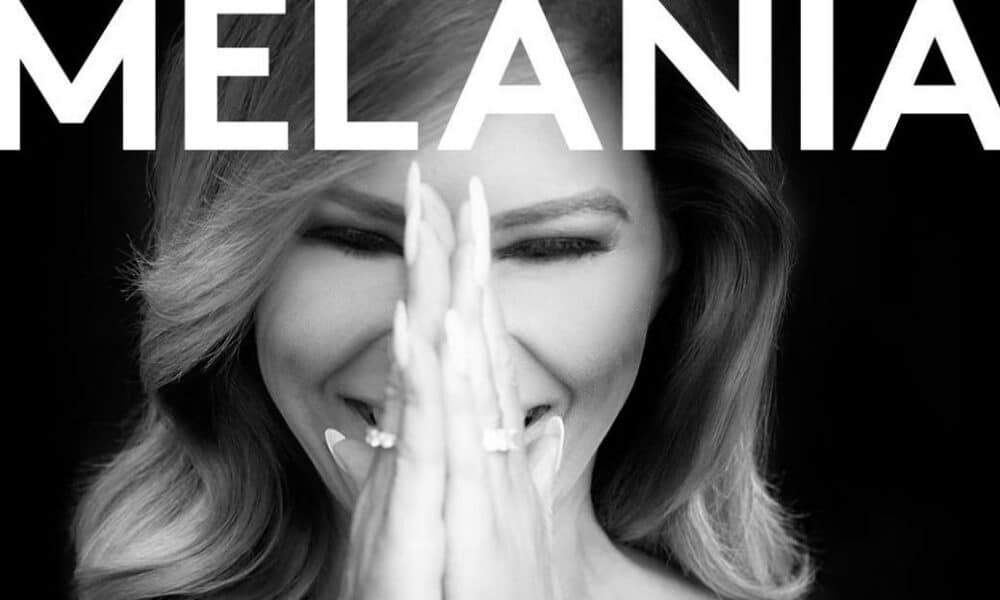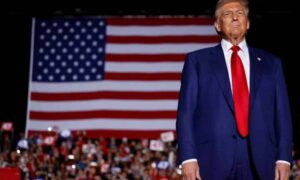On Monday, January 27, Melania Trump’s official portrait as First Lady of the United States was unveiled on the White House’s official social media account. The image, captioned “First Lady Melania Trump’s Official White House Portrait,” aimed to project elegance and authority. However, the timing of its release has sparked significant controversy, as it coincides with the Trump administration’s strict immigration policies and recent deportations, drawing criticism both domestically and internationally.
Born in the former Yugoslavia, now Slovenia, in 1970, Melania Trump immigrated to the United States and later became a naturalized citizen before marrying Donald Trump. While her rise to the role of First Lady is often celebrated as a manifestation of the American Dream, critics argue that her immigrant background starkly contrasts with the administration’s harsh stance on immigration. The portrait’s release led to immediate backlash, with many questioning the contradictory image of promoting an immigrant First Lady while enforcing policies that heavily target immigrants.
Social Media Reactions and the Immigration Debate
The release of the portrait was met with a flood of reactions on social media, many of which highlighted perceived inconsistencies in the administration’s stance on immigration. Comments ranged from criticism of the government’s deportation policies to sarcastic remarks about Melania’s immigrant background. One user wrote, “Publishing an immigrant while deporting others or removing birthright citizenship is insanity.” Another commented, “Make sure to deport her too.”
These responses illustrate the polarized perception of Melania Trump’s role within the administration. For supporters, she embodies grace and resilience; for critics, she represents the contradictions of the Trump era. The debate reignites discussions about the administration’s immigration policies, which have led to widespread deportations and heightened scrutiny of immigrants in the U.S.
Recent Deportations and Diplomatic Strains
The portrait’s release comes amid heightened tensions surrounding U.S. immigration policies. One significant development was the deportation of Brazilian nationals, with the first flight of deportees arriving in Manaus, Brazil, on Friday, January 24. These flights are part of a bilateral agreement signed in 2018 between the U.S. and Brazil, aimed at expediting the deportation process for Brazilian nationals detained in the U.S. for immigration violations.
During the flight to Manaus, deported individuals were reportedly handcuffed, a standard practice in such operations according to U.S. authorities. However, this treatment sparked criticism in Brazil, particularly as the deportees were not classified as prisoners upon arrival. Upon landing, the handcuffs were removed, but reports of disputes on the flight—stemming from extreme heat—added to the controversy. Some passengers opened an emergency door and exited the aircraft via an inflatable ramp, highlighting the tense conditions surrounding these deportation flights.
The Symbolism of Melania Trump’s Portrait
Melania Trump’s official portrait was designed to reinforce her status as a key representative of the Trump administration. However, it also underscores the tension between her role as an immigrant First Lady and the administration’s restrictive policies. Her “Be Best” campaign, focused on child welfare and cyberbullying, has attempted to build a separate public identity for her, but criticism of the campaign’s effectiveness persists.
As an immigrant herself, Melania’s journey to becoming First Lady contrasts sharply with the administration’s measures to restrict immigration. This contradiction has fueled debates about the role of public figures in shaping national narratives and policies. While her supporters view her as a symbol of the opportunities available in America, her critics see her as emblematic of the administration’s conflicting messages.
Key Data and Statistics on Deportations
- On January 24, a deportation flight landed in Manaus, Brazil, carrying Brazilian nationals detained in the U.S.
- The deportees were part of a bilateral deportation agreement between the U.S. and Brazil, signed in 2018.
- Deportees were reportedly handcuffed during the flight, following standard U.S. procedures for such operations.
- Disputes arose mid-flight due to extreme heat, leading some passengers to activate emergency exits.
- The deportations have intensified scrutiny of U.S. immigration policies and their humanitarian implications.
Fascinating Facts About Melania Trump
- Melania Trump is the second First Lady in U.S. history to be born outside the country, the first being Louisa Adams.
- Before marrying Donald Trump, Melania had a successful modeling career, working with major fashion brands.
- She is fluent in five languages: Slovenian, English, French, Italian, and German.
- Her “Be Best” campaign seeks to promote child welfare and combat cyberbullying, though critics have pointed to inconsistencies with her husband’s social media behavior.
Contradictions in Melania Trump’s Public Image
The unveiling of Melania Trump’s official portrait highlights the complexities of her role as First Lady. For many, she represents poise and achievement, yet for others, she serves as a reminder of the contradictions in the administration’s policies. The image of an immigrant First Lady juxtaposed with a government enforcing strict anti-immigration measures has amplified criticism and sparked wider debates about identity, representation, and policy.
The timing of the portrait’s release, amidst increased deportations, further emphasizes these contradictions. Melania Trump’s background as an immigrant and her prominence as a public figure place her at the center of discussions about immigration reform and the treatment of immigrant communities.
Humanitarian Concerns in Immigration Policy
The Trump administration’s deportation policies have faced ongoing criticism from human rights organizations. Concerns include the treatment of deportees during transit and the broader implications of expedited deportation agreements. The use of handcuffs during flights, the conditions on board, and the emotional toll on deported individuals have all been scrutinized. Additionally, the diplomatic tensions created by these policies highlight the need for more balanced and humane approaches to immigration.

On Monday, January 27, Melania Trump’s official portrait as First Lady of the United States was unveiled on the White House’s official social media account. The image, captioned “First Lady Melania Trump’s Official White House Portrait,” aimed to project elegance and authority. However, the timing of its release has sparked significant controversy, as it coincides with the Trump administration’s strict immigration policies and recent deportations, drawing criticism both domestically and internationally.
Born in the former Yugoslavia, now Slovenia, in 1970, Melania Trump immigrated to the United States and later became a naturalized citizen before marrying Donald Trump. While her rise to the role of First Lady is often celebrated as a manifestation of the American Dream, critics argue that her immigrant background starkly contrasts with the administration’s harsh stance on immigration. The portrait’s release led to immediate backlash, with many questioning the contradictory image of promoting an immigrant First Lady while enforcing policies that heavily target immigrants.
Social Media Reactions and the Immigration Debate
The release of the portrait was met with a flood of reactions on social media, many of which highlighted perceived inconsistencies in the administration’s stance on immigration. Comments ranged from criticism of the government’s deportation policies to sarcastic remarks about Melania’s immigrant background. One user wrote, “Publishing an immigrant while deporting others or removing birthright citizenship is insanity.” Another commented, “Make sure to deport her too.”
These responses illustrate the polarized perception of Melania Trump’s role within the administration. For supporters, she embodies grace and resilience; for critics, she represents the contradictions of the Trump era. The debate reignites discussions about the administration’s immigration policies, which have led to widespread deportations and heightened scrutiny of immigrants in the U.S.
Recent Deportations and Diplomatic Strains
The portrait’s release comes amid heightened tensions surrounding U.S. immigration policies. One significant development was the deportation of Brazilian nationals, with the first flight of deportees arriving in Manaus, Brazil, on Friday, January 24. These flights are part of a bilateral agreement signed in 2018 between the U.S. and Brazil, aimed at expediting the deportation process for Brazilian nationals detained in the U.S. for immigration violations.
During the flight to Manaus, deported individuals were reportedly handcuffed, a standard practice in such operations according to U.S. authorities. However, this treatment sparked criticism in Brazil, particularly as the deportees were not classified as prisoners upon arrival. Upon landing, the handcuffs were removed, but reports of disputes on the flight—stemming from extreme heat—added to the controversy. Some passengers opened an emergency door and exited the aircraft via an inflatable ramp, highlighting the tense conditions surrounding these deportation flights.
The Symbolism of Melania Trump’s Portrait
Melania Trump’s official portrait was designed to reinforce her status as a key representative of the Trump administration. However, it also underscores the tension between her role as an immigrant First Lady and the administration’s restrictive policies. Her “Be Best” campaign, focused on child welfare and cyberbullying, has attempted to build a separate public identity for her, but criticism of the campaign’s effectiveness persists.
As an immigrant herself, Melania’s journey to becoming First Lady contrasts sharply with the administration’s measures to restrict immigration. This contradiction has fueled debates about the role of public figures in shaping national narratives and policies. While her supporters view her as a symbol of the opportunities available in America, her critics see her as emblematic of the administration’s conflicting messages.
Key Data and Statistics on Deportations
- On January 24, a deportation flight landed in Manaus, Brazil, carrying Brazilian nationals detained in the U.S.
- The deportees were part of a bilateral deportation agreement between the U.S. and Brazil, signed in 2018.
- Deportees were reportedly handcuffed during the flight, following standard U.S. procedures for such operations.
- Disputes arose mid-flight due to extreme heat, leading some passengers to activate emergency exits.
- The deportations have intensified scrutiny of U.S. immigration policies and their humanitarian implications.
Fascinating Facts About Melania Trump
- Melania Trump is the second First Lady in U.S. history to be born outside the country, the first being Louisa Adams.
- Before marrying Donald Trump, Melania had a successful modeling career, working with major fashion brands.
- She is fluent in five languages: Slovenian, English, French, Italian, and German.
- Her “Be Best” campaign seeks to promote child welfare and combat cyberbullying, though critics have pointed to inconsistencies with her husband’s social media behavior.
Contradictions in Melania Trump’s Public Image
The unveiling of Melania Trump’s official portrait highlights the complexities of her role as First Lady. For many, she represents poise and achievement, yet for others, she serves as a reminder of the contradictions in the administration’s policies. The image of an immigrant First Lady juxtaposed with a government enforcing strict anti-immigration measures has amplified criticism and sparked wider debates about identity, representation, and policy.
The timing of the portrait’s release, amidst increased deportations, further emphasizes these contradictions. Melania Trump’s background as an immigrant and her prominence as a public figure place her at the center of discussions about immigration reform and the treatment of immigrant communities.
Humanitarian Concerns in Immigration Policy
The Trump administration’s deportation policies have faced ongoing criticism from human rights organizations. Concerns include the treatment of deportees during transit and the broader implications of expedited deportation agreements. The use of handcuffs during flights, the conditions on board, and the emotional toll on deported individuals have all been scrutinized. Additionally, the diplomatic tensions created by these policies highlight the need for more balanced and humane approaches to immigration.







